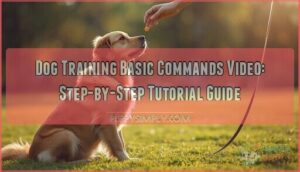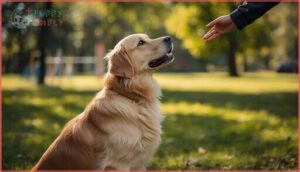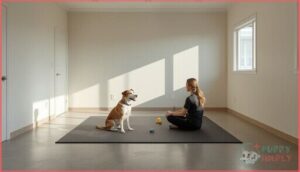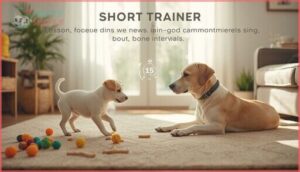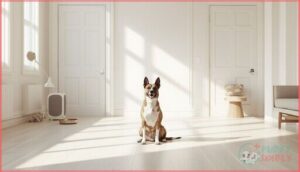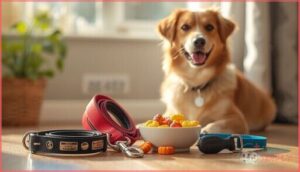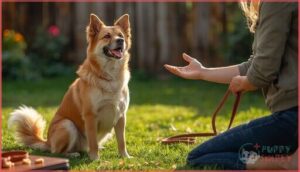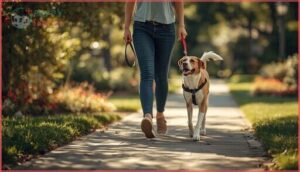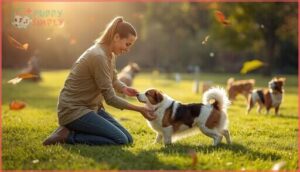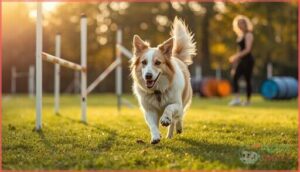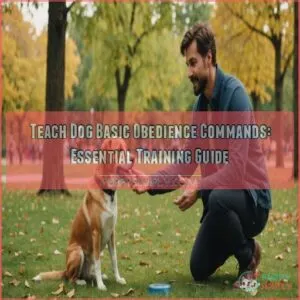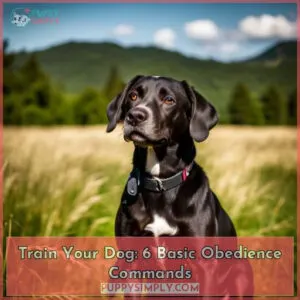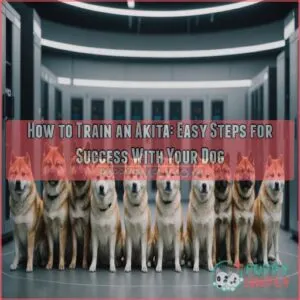This site is supported by our readers. We may earn a commission, at no cost to you, if you purchase through links.
Most dogs know how to sit when a treat appears, but mastering basic commands goes far beyond a quick snack and a wagging tail. The difference between a calm walk and a tangled leash often comes down to the right training—done at the right moment, in the right way.
You’ve seen those smooth “dog training basic commands video” clips where a pup responds instantly, and wondered how trainers make it look so easy. It’s not magic. It’s a blend of clear cues, smart rewards, and steady practice. When you understand the core steps, you’ll see your dog’s confidence grow—and yours right alongside.
Table Of Contents
- Key Takeaways
- Essential Commands Every Dog Should Know
- Setting Up for Successful Training Sessions
- Positive Reinforcement Training Methods
- Combining Verbal Cues and Hand Signals
- Leash Manners and Walking Commands
- Overcoming Common Training Challenges
- Advancing Skills and Maintaining Progress
- Frequently Asked Questions (FAQs)
- How to train a dog basic commands?
- What are puppy training commands?
- What are dog commands?
- How to train a dog?
- How is behavior modification different from obedience training?
- Can all ages and breeds of dogs learn commands?
- What impact does training have on a dogs personality?
- What are the key benefits of Leave It command?
- How long does it take to train a dog fully?
- How do I train my dog to greet politely?
- Conclusion
Key Takeaways
- Training success comes from precise timing—reward your dog within one to two seconds of the correct behavior to create clear connections between cues and actions.
- Build commands in layers by mastering one variable at a time: start with short duration in quiet spaces, then gradually increase distance and add distractions while maintaining high success rates.
- The five foundation commands—sit, stay, come, down, and leave it—give you practical tools to manage safety, control impulses, and strengthen your bond in real-world situations.
- Combine verbal cues with distinct hand signals from the start, then fade the voice over time to create silent commands that work in noisy environments or at greater distances.
Essential Commands Every Dog Should Know
Building a solid foundation starts with teaching your dog a handful of core commands that work in almost any situation.
These basics give you the tools to manage behavior, keep your dog safe, and strengthen your bond.
Let’s walk through the five essential commands that every dog should master.
Sit Command Fundamentals
The sit command anchors your dog’s basic obedience training and sets the tone for everything that follows. Hold a treat close to your dog’s nose and lift it slowly upward. As their head tilts back, their rear naturally lowers into a calm sitting position. Mark the moment with “sit” and deliver the reward within one second.
Pair your verbal cue with a consistent hand signal—palm down, moving toward their hips. Practice this sequence in short sessions, keeping your tone neutral and your timing precise.
Sit positioning becomes reliable when you reward immediately and use the same cue every time. Consistent training methods require understanding of clear science concepts.
Stay Command Training
Once your dog reliably holds a sit, build the stay command by pairing it with a clear hand signal—palm facing forward. Start with just three seconds before using a release cue like “okay” to end the position. This teaches impulse control and boundary training through positive reinforcement.
- Begin in quiet spaces with minimal distractions
- Gradually extend duration by two-second intervals
- Step back one pace to test distance reliability
- Shift to silent commands once verbal cues fade
Mark successful stays with immediate rewards to strengthen basic obedience commands. Consistent training also involves addressing methodological flaws to guarantee reliable outcomes.
Come (Recall) Command
After your dog masters staying put, teach them to return on cue. Start recall techniques indoors with minimal distractions. Say “come” and reward immediately when they reach you. Use leash guidance to reinforce the behavior during distance training.
| Training Phase | Focus Area |
|---|---|
| Initial Practice | Close-range response times |
| Mid-Stage | Reward systems with high-value treats |
| Final Work | Come when called in varied settings |
This basic obedience commands foundation builds reliable dog obedience through positive reinforcement and consistent dog training sessions.
Down Command Technique
Once your dog responds reliably to recall, teach the down position from either sit or stand. Use lure techniques by guiding a treat from their nose toward the ground and under their chest. Pair this motion with clear verbal cueing using a calm, firm voice.
- Keep your dog’s body alignment straight to prevent twisting
- Reward immediately when they assume the full down position
- Start with 1-2 second holds before gradually increasing duration
- Practice reward systems with high-value treats for consistent success
This basic obedience commands skill builds impulse control through positive reinforcement training.
Leave It Command
Forbidden items become teaching moments when you master this essential command. Start by placing a low-value object on the ground and say “leave it” once. Guide your dog’s attention away within 1-2 seconds using command timing that prevents access. Track compliance rates across sessions and reward alternative focus immediately.
| Training Phase | Success Marker | Common Error |
|---|---|---|
| Introduction | Eyes shift from item | Rewarding brief glances |
| Building Duration | No drift for 5+ seconds | Delayed verbal cue |
| Distraction Control | 90%+ compliance rate | Inconsistent reward systems |
| Real-World Practice | Ignores item independently | Practicing only indoors |
This positive reinforcement training builds impulse control in puppy training and basic training programs. Use high-value treats to reinforce desired dog behavior consistently.
Setting Up for Successful Training Sessions
Your training setup can make or break your dog’s ability to learn. Getting the basics right from the start saves you hours of frustration and sets your dog up to succeed.
Let’s look at the key elements you need to create an environment where your dog can focus and thrive.
Choosing The Right Training Environment
Your training space sets the tone for every command your dog will master. Start indoors where you control environmental factors and distractions run low. Research shows dogs learn sit and stay up to 30% faster in quiet rooms than busy yards.
- Choose non-slip surfaces like carpet or rubber mats to prevent slipping during down commands
- Remove toys and turn off TVs to keep your dog’s focus sharp
- Secure the area with closed doors or a fenced yard for safe recall practice
- Provide 10-15 square meters of clear space for movement during come exercises
- Pick rectangular layouts over cluttered rooms to simplify your dog’s understanding
Surface types matter for safety and confidence building through positive reinforcement training techniques.
Optimal Session Length and Frequency
Frequently, trainers underestimate how short sessions should be. Puppies thrive on 5–10 minutes of basic training, while adult dogs handle 10–15. Run 2–3 daily routines to lock in commands without triggering fatigue.
Track your dog’s performance—when accuracy hits 80–90%, you’re ready to layer in distractions. Smart session timing and training frequency turn puppy training tips into lasting dog obedience through reward-based training.
Minimizing Distractions During Practice
Your training space acts like a sanctuary where commands stick. Choose a quiet room with minimal foot traffic and shut the door to eliminate visual and auditory interruptions during your practice routine.
- Remove toys, food bowls, and other pets before basic training
- Use white noise to mask unpredictable sounds from outside
- Start indoors, then gradually introduce distractions for focus building
- Keep positive reinforcement rewards hidden until needed
Distraction control transforms scattered attention into reliable responses during loose-leash walking and clicker training sessions.
Gathering Necessary Training Supplies
Success hinges on having the right tools before you begin. Gather your training gear early so sessions flow without interruption.
| Item | Purpose | Key Feature |
|---|---|---|
| Flat collar or chest strap | Secure attachment | ID tags with contact info |
| 6-8 foot leash | Basic control for leash manners | Lightweight and durable |
| High-value treats | Positive reinforcement | Low-calorie, bite-sized |
| Clicker device | Precise timing marker for clicker training | Clear, consistent sound |
Proper chest strap fitting and treat choices transform dog training and obedience from frustrating to rewarding.
Positive Reinforcement Training Methods
Positive reinforcement is at the heart of modern dog training and helps shape reliable behavior. You’ll want to use the right tools and techniques to keep your dog motivated.
Here’s how you can make every training session rewarding and effective.
Using High-Value Treats Effectively
Ever wonder why your dog’s eyes light up for a sliver of chicken but barely budge for kibble? Treat selection matters. High-value treats boost motivation, especially in positive reinforcement and reward-based training.
Match treat size to your dog and task difficulty, keeping calorie control in mind. Rotate flavors to prevent boredom. Fresh, tempting treats keep operant conditioning and dog training and obedience sharp.
Proper Timing of Rewards
A tempting treat means nothing if your timing is off. Reward Delivery must be instant—within two seconds of the behavior—to lock in that clear contingency.
Synchronized Rewards are the backbone of reward-based training and Operant Conditioning. Timing Consistency drives obedience training and Behavior Modification and Management.
Think of it as catching lightning in a bottle: quick, precise, and always predictable.
Clicker Training Basics
Just as timing matters with treats, Clicker Timing is the heartbeat of reward-based training. You’ll use a handheld clicker—waterproof and sharp—to mark behaviors the instant they happen.
This precise Behavior Marking, rooted in Operant Conditioning, creates a clear link for your dog.
Training Phases start simple, and reliable Reward Systems build lasting Canine Training results across Animal Training Techniques.
Praise and Affection as Motivation
Clickers work wonders for reward-based training, but don’t overlook Affection Rewards. A gentle pat, quiet praise, or soft eye contact builds an Emotional Connection that strengthens your Training Bonds.
For some dogs, these Motivation Techniques rival treats. You’ll see sharper Pet Obedience and improved Dog Behavior when Positive Reinforcement includes genuine affection, especially during puppy behavior modification and everyday Canine Training.
Combining Verbal Cues and Hand Signals
Teaching your dog with both words and hand signals builds stronger communication. You’ll find it easier to guide your dog in any situation when you use both together.
Here’s how you can start using these techniques step by step.
Clear Verbal Command Selection
Think of each command as a password—only the right word unlocks the behavior you want. Command Clarity matters. Stick to distinct phrasing like sit, stay, down, or come when called.
Use a consistent tone and clear pronunciation every time. Matching each Verbal Cue to one action helps your dog master loose-leash walking and other skills without confusion.
Basic Hand Signal Techniques
A steady hand is your best tool for Signal Consistency. Keep your Hand Positioning distinct—palm up for sit, flat for stay, finger point for down.
Visual Clarity matters, especially during loose-leash walking or come when called. Cue Timing is key: show the signal, then reward immediately.
Reliable Reward Systems reinforce each command, helping your dog decode signals with confidence.
Pairing Signals With Voice Commands
Your dog builds Neural Links when you deliver the Hand Signal and spoken cue together every time. Start with sit, stay, or down—pair the flat palm with “stay” and reward within one second. That tight Reward Timing cements Cue Association. Practice during loose-leash walking and come when called so Signal Consistency becomes second nature.
- Choose a short, distinct verbal cue for each command
- Show the hand signal at the exact moment you say the word
- Reward correct responses immediately to strengthen the connection
- Keep your training environment calm to reduce distractions
- Track your dog’s success rate to monitor progress over time
Transitioning to Silent Commands
Mastery of Silent Cueing begins when your hand signals replace spoken words completely. Start Verbal Fading by whispering “sit” or “stay” while keeping your palm visible, then drop the voice altogether.
This Nonverbal Communication sharpens Command Reliability in noisy parks and during loose-leash walking.
Reward-based training still applies—treat every correct response to silent come-when-called cues to lock in that confidence.
Leash Manners and Walking Commands
Teaching your dog proper leash manners is one of the best ways to make walks enjoyable and safe. You’ll want a clear plan for building good habits right from the start.
Here’s what to focus on as you train those essential walking commands.
Loose-Leash Walking Foundation
Ever notice how a steady leash sets the tone for every walk? Leash Training Tips start with a well-fitted collar and a six-foot leash.
Handler Positioning matters—redirect with gentle side steps, not corrections.
Use Walking Techniques like alternating rewards and positive interrupters for Pulling Prevention.
Practicing loose-leash walking builds Canine Communication skills, making sit, stay, and down easier to reinforce.
Stop and Wait Techniques
Imagine your leash is a pause button. The Wait Command and Stop Signals teach your dog to halt and hold position, whether at doorways or crosswalks.
Calm Cues and Pause Training add control, letting you reinforce sit, stay, or down.
With loose-leash walking and reward-based training, your dog learns patience—waiting calmly for your next move.
Heel Command for Controlled Walking
A steady gait beside your left leg sets the tone for true Heel Positioning. You’ll manage Leash Tension by keeping the leash slack and matching your Walking Pace to your dog’s stride.
Focus on Handler Alignment—your dog’s shoulder should line up with your knee. Reward Timing is key; praise or treats reinforce good Leash Manners and loose-leash walking every step.
Managing Pulling Behavior
If your dog pulls ahead, Leash Training starts with Pulling Prevention and smart Chest Strap Options. Use a front-attach chest strap to cut their momentum.
Try structured Walking Techniques—alternate sit and stay with loose-leash walking.
Keep Reward Schedules tight; high-value treats every few steps help. These Leash Manners, paired with regular practice, can reduce pulling incidents by over half.
Overcoming Common Training Challenges
Every dog faces a few bumps along the road to learning. You’ll notice some common challenges as you work through basic commands together.
Here’s what to look out for and how you can handle each one.
Dealing With Distracted Dogs
A distracted dog needs structure and smart environmental control. You boost training focus by managing sensory input—close doors, limit movement, and keep sessions short.
Use high-value reward systems for sit, stay, or loose-leash walking. Reward-based training paired with clear dog communication builds reliability.
Practice in calm settings first, then weave in distractions as your dog’s focus improves.
Addressing Stubborn or Unresponsive Behavior
If your dog tunes out, start by lowering distractions and shortening sessions—two minutes is plenty. Use high-value rewards and break tasks into small steps. Consistency matters here; repeat cues daily and track progress.
Patient, reward-based training draws on canine behavioral psychology, guiding stubborn dogs toward compliance. Animal behavior modification works best when you stay calm, persistent, and keep your expectations realistic.
Building Focus and Attention
Once your reward-based training gets your dog listening, it’s time to sharpen focus. Calm environments set the stage for attention building—think quiet rooms with few distractions. Use clear cues for sit, down, and loose-leash walking. Quick rewards and short intervals keep eyes on you.
These focus techniques, paired with consistent distraction management, anchor Canine Behavior and Psychology for steady progress.
Training Through Fear or Anxiety
Stress management is as important as teaching commands. Fear-based methods and aversive techniques can increase anxiety, making learning more difficult and potentially leading to defensive behavior.
Fear-based training methods can raise anxiety and make learning harder, often leading to defensive or stressed behavior in dogs
Ethical training emphasizes reward-based methods for anxiety reduction and better puppy development. For Canine Good Citizen goals, guide your dog with patience.
Understanding canine behavior and psychology reveals that calm, positive environments help your dog thrive.
Advancing Skills and Maintaining Progress
Once your dog has mastered the basics, it’s time to raise the bar. Progress comes from stretching their skills in new ways.
Here are some practical steps you can use to keep your dog’s training moving forward.
Increasing Duration, Distance, and Distractions
Once your dog reliably responds at close range, you’re ready to add challenge. The three pillars of expert training—duration, distance, and distraction management—turn basic cues like sit and down into tools you can trust anywhere.
- Build duration gradually: Start with five-second holds and add 2–5 minutes weekly during progressive learning sessions.
- Extend distance methodically: Practice recall and loose-leash walking from 5 feet to 25 feet using a long line for consistency building.
- Introduce distractions slowly: Use high-value treats in quiet spaces first, then add mild stimuli while maintaining reward-based training principles.
- Master one variable first: Increase duration at fixed distance before extending range, following Canine Good Citizen standards for reliable performance.
Practicing Commands in New Environments
Your living room isn’t the real world. Environmental adaptation means testing sit, down, and loose-leash walking where life happens—parks, sidewalks, pet stores. Start with short recall drills in unfamiliar rooms before venturing outdoors. Novelty exposure builds contextual learning as your dog masters generalization techniques across settings. Use high-value rewards during puppy socialization to strengthen distraction management and reward-based training through changing conditions.
| Training Stage | Environment Type | Commands to Practice | Session Length | Key Focus |
|---|---|---|---|---|
| Stage 1 | Quiet Indoor Rooms | Sit, Down, Name Response | 3-5 minutes | Novelty Exposure |
| Stage 2 | Enclosed Outdoor Yard | Recall, Stay, Loose-Leash | 5-8 minutes | Environmental Adaptation |
| Stage 3 | Low-Traffic Public Spaces | All Basic Commands | 8-12 minutes | Contextual Learning |
| Stage 4 | Moderate Distraction Areas | Multi-Command Sequences | 10-15 minutes | Generalization Techniques |
| Stage 5 | High-Stimulus Environments | Full Command Reliability | 12-20 minutes | Distraction Management |
Incorporating Training Into Daily Routines
Training doesn’t require a formal session—it’s woven into what you’re already doing. Morning Training starts with a quick sit before breakfast, reinforcing Feeding Cues through reward-based training.
During Household Chores, practice down while you fold laundry. Evening Practice includes loose-leash walking before dinner.
These Daily Routine Tips transform puppy socialization into habit, building consistency without adding hours to your day.
Building Multi-Step Command Sequences
Ever tried weaving commands together like links in a chain? Sequence Training builds Cue Chains for real-world Command Flow—think sit, down, then loose-leash walking. Start with two steps, reinforce each with precise timing.
Gradually add complexity, just as you’d for AKC STAR Puppy prep. Multi-Step routines, practiced across new settings, turn reward-based training into reliable daily habits.
Frequently Asked Questions (FAQs)
How to train a dog basic commands?
Start with Basic Obedience like sit and down using reward-based training. Keep sessions short and positive. Practice loose-leash walking and use clear cues.
Dog Socialization and Puppy Training build Canine Behavior skills for AKC STAR Puppy success.
What are puppy training commands?
Puppy training commands like sit, stay, come, down, and leave it form the backbone of Basic Obedience.
These cues support Puppy Socialization, Canine Communication, and reward-based Training Techniques for healthy Dog Behavior and overall puppy care and development.
What are dog commands?
Dog commands are clear cues—spoken or signaled—that guide your dog’s behavior. Command Types like sit, down, and loose-leash walking build Canine Communication.
Obedience Fundamentals and reward-based training help you shape reliable habits with practical dog owner guidance.
How to train a dog?
Why do some dogs listen while others ignore you? The answer lies in using reward-based training, clear cues like sit and down, proper training tools, and consistent routines.
Focus on dog socialization, housebreaking, and loose-leash walking for balanced canine behavior.
How is behavior modification different from obedience training?
Behavior modification targets root causes like anxiety or reactivity, using modification techniques from canine psychology.
Obedience methods focus on task cues—sit, down, loose-leash walking—reward-based training builds compliance, while housebreaking and behavior plans aim for broader, lasting change.
Can all ages and breeds of dogs learn commands?
No matter their age or breed, most can learn sit, down, and loose-leash walking with reward-based training. Cognitive Development, Age Factors, and Breed Variations shape progress, but Training Adaptations help overcome Learning Barriers for effective Pet Care and Management.
What impact does training have on a dogs personality?
Training reshapes behavioral flexibility and emotional stability in profound ways. Studies show consistent practice reduces impulsivity by nearly 40%.
Commands like sit and down build confidence, while reward-based training strengthens social adaptation and lowers stress reactivity over time.
What are the key benefits of Leave It command?
You gain Impulse Control and Risk Reduction when teaching this boundary-setting skill.
It prevents harmful ingestion, fosters Safe Interactions with children and wildlife, and facilitates better Distraction Management during recall training.
How long does it take to train a dog fully?
Ironically, there’s no finish line. Most dogs show solid sit and down within two months of consistent, reward-based training, but full fluency—including loose-leash walking and crate drills—unfolds across four to twelve months, shaped by breed factors and individual progress.
How do I train my dog to greet politely?
Teach your dog to sit before guests arrive, then reward calm behavior. Use a leash to manage access and practice greeting etiquette with controlled visitor management.
Consistent reward-based training builds polite interactions and proper dog socialization skills.
Conclusion
Training your dog is like building a bridge—one solid plank at a time. Each command you teach creates a stronger connection between you and your companion.
The dog training basic commands video techniques you’ve learned here give you the foundation to shape behavior with patience and consistency.
Start small, stay focused, and watch your dog transform into a confident partner. The work you put in today builds trust that lasts a lifetime.
- https://www.youtube.com/watch?v=UBXUTmmZKLg
- https://arxiv.org/html/2507.17948v2
- https://www.writingclearscience.com.au/category/writing-guides/writing-research-papers/page/2/
- https://academichelpexpress.blog/2024/08/please-use-the-bulleted-points-and-the-rubric-below-to-guide-your-work-your-pa/
- https://www.linkedin.com/posts/bohdanlukianets_tasks-study-research-activity-7373377539521667072-UTEi

